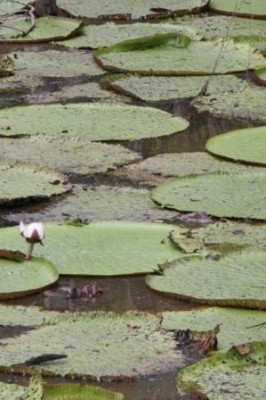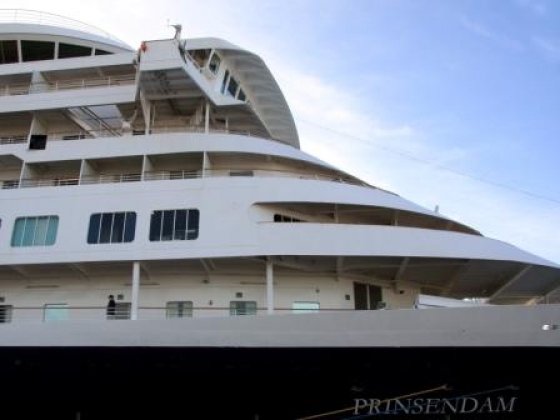 Als Manaus, zoals gezegd, elfduizend vierkante kilometer groot is, dan is “rondom Manaus” op één dag wel grote titel voor een klein stukje. Eigenlijk was het een tocht met boot en kano’s naar de jungle in en rond “Lake January”. De reden waarom het zo noemt is simpel: van februari t/m oktober is dit geen meer meer(!?) – met dank aan het wassende water van de alles-inpalmende Solimoes. Tussen haakjes, dat is de naam van de rivier alvorens ze de Rio Negro ontmoet. De samenvloeiing schuift dan tientallen kilometers op naar het westen. Als gevolg dervan wordt de Amazone in mei hier méér dan 40km breed. ’t Was dus nu of nooit.
Als Manaus, zoals gezegd, elfduizend vierkante kilometer groot is, dan is “rondom Manaus” op één dag wel grote titel voor een klein stukje. Eigenlijk was het een tocht met boot en kano’s naar de jungle in en rond “Lake January”. De reden waarom het zo noemt is simpel: van februari t/m oktober is dit geen meer meer(!?) – met dank aan het wassende water van de alles-inpalmende Solimoes. Tussen haakjes, dat is de naam van de rivier alvorens ze de Rio Negro ontmoet. De samenvloeiing schuift dan tientallen kilometers op naar het westen. Als gevolg dervan wordt de Amazone in mei hier méér dan 40km breed. ’t Was dus nu of nooit.
Omdat vogelen op het handelskot in Leuven geen keuzevak was, kan ik over vandaag niet veel vertellen. Het zogenoemde meer was in feite een vogelparadijs waar de bloemen en krokodillen alleen maar dienden als decor. Dat was ook het onaantrekkelijke lot van de “vlottende huizen” waarop er in Brazilië geen grondbelasting is zolang het huis nooit op vaste grond komt: prima regeling voor de arme mensen. Aangezien elke dag van adres veranderen nogal omslachtig wordt, stelt zich wel de vraag hoe men dan op dezelfde plek kan blijven wonen? Antwoord: je zoekt een boom waaraan je jouw “ponthuis” met een koord vastmaakt! (Volgens de gids moet je er wel voor zorgen dat je de buren niet tegen het hoofd stoot, figuurlijk, zoniet wordt je “los gekapt”). Dat is het verhaal van deze tweede maandag. Op naar Carnaval!
Prinsendam, maandag 17 januari 2011, 16:18u
Pas vertrokken, stroomafwaarts naar de oceaan!
Wie vindt de alligator op de foto hieronder?
 P.S. Een paar tips van de indiaanse gids voor bezoekers in spe – belangrijke praktische info over vissen – wil ik u niet onthouden.
P.S. Een paar tips van de indiaanse gids voor bezoekers in spe – belangrijke praktische info over vissen – wil ik u niet onthouden.
1) Van piranha’s moet je helemaal niet bang zijn; zolang je nergens een wonde hebt, kan je lustig rondzwemmen en zijn piranha’s gewoon collega’s: zij zwemmen ook lustig rond. Weet wel dat één wondje – een bloedspoor dus, hun vraatzucht onmiddellijk aanwakkert. Op dat moment is het goed te weten welke van de 23 soorten piranha’s moeten vermeden worden. Voor de weetgierigen onder de lezers heb ik ook navraag gedaan over het “waarom”. Er zijn drie soorten piranha’s die u, bij kwetsuur – hoe klein ook, moeten aansporen om zo snel mogelijk uit het water te stappen, springen, lopen of zwemmen (dat laatste is minder aangewezen), te weten:
a) de roodbuikige piranha, waarom? – zij bijten zéér, zéér snel (hun bakkes staat niet stil!)
b) de zwartbuikige piranha, waarom? – zij zijn groot (50cm) en nemen grote happen
c) de “cachoe” (uitspreken zoals Vlaams rubber), waarom? – zij zwemmen in scholen, capiesj??
2) De inboorlingen zijn niet bang van piranha’s. Ze zijn een beetje bang van de elektrische aal en van de “Stingray” (rog). Hun grootste zorg is echter de … canjiriu (kan-zjie-ri-joe). Dit zijn dichtbij het wateroppervlak zwemmende visjes van 5cm maximaal die zich … vastzetten in het lichaam. Zij hebben ook twee “fangen”, met weerhaken, die ze uitsteken als ze eenmaal “binnen” zijn, zodat ze ook niet kunnen terug getrokken, en zo verwijderd worden. Ze zitten muurvast en vreten hun weg voorruit. Bij zwemmers kruipen ze nogal eens in de oren of de neus, soms de mond als je onder water probeert adem te halen (grapje!!). Waarom vrezen de vissers echter deze beestjes? Simpel: als ze in ondiep water uit hun boot moeten stappen omdat de netten vastzitten, of de schroef in het gras of riet is vastgelopen, loert het gevaar. En in welk gaatje denk je dat de canjiriu zich dan gaan nestelen? Eén keer raden! De enige remedie is zeer snel naar het hospitaal om opengesneden te worden! Tussen haakjes: door urine worden ze aangetrokken – vooral niet p….!!

 Since I am not an ornithologist, there is not much that I can tell about the many birds of the Amazon. The lake itself was, in essence, a bird’s paradise where flowers and caymen (alligators) were only a fixture in the surrounding stage. On that same stage one couldn’t miss the “floating houses”: at first sight rather unattractive homes for their Indian inhabitants. The good news is that the Brazilian government doesn’t levy any estate tax as long as the house never really is attached to the land. It seems like an excellent ordinance to benefit poor people. Because changing a domicile on a daily basis is rather cumbersome, the question arises how to arrange to stay and live at the same address? Answer: you find a tree around which you fix a rope that also secures your “home float”. Make sure you don’t get into trouble with the neighbors though, because they might cut you loose!
Since I am not an ornithologist, there is not much that I can tell about the many birds of the Amazon. The lake itself was, in essence, a bird’s paradise where flowers and caymen (alligators) were only a fixture in the surrounding stage. On that same stage one couldn’t miss the “floating houses”: at first sight rather unattractive homes for their Indian inhabitants. The good news is that the Brazilian government doesn’t levy any estate tax as long as the house never really is attached to the land. It seems like an excellent ordinance to benefit poor people. Because changing a domicile on a daily basis is rather cumbersome, the question arises how to arrange to stay and live at the same address? Answer: you find a tree around which you fix a rope that also secures your “home float”. Make sure you don’t get into trouble with the neighbors though, because they might cut you loose!